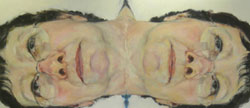by Christine Unger
December 28, 2008
|
 |
|
Holly Tingley
Irene, Irene
oil on canvas
|
Holly Tingley’s paintings exist in a phenomenological tradition—evoking the condition of perception in both their subject matter and their execution. They balance between well-conceived technical approaches that indicate the direction of her thoughts and an understanding approach to her subjects. The application of reflection, doubling, as well as the submersive layering of her canvases, convey the uncanny impermanence of the present, and the elusive nature of time. At the same time the sensitive lines and strokes that describe her figures add conviction and sincerity to a somewhat eerie perception of the world. The traces of Tingley’s process remain apparent and integral in her final paintings. The folded canvas disallows the illusionist potential of a direct and unbroken surface while affirming the disjunction of the observed from one blink of an eye to the next. She questions the structure of time and the certainty of the captured image. Her works propose the verity and the consolation of indefinite time.
Tingley’s work follows a highly focused philosophical enquiry into the nature of identity elicited by the real or perceived presence of a double: a twin, a doppelganger, a double image, a reflection. The doppelganger and the twin have long been subjects of her work both directly and indirectly. Her fascination is more than a rich source of distanced contemplation. It is very evidently an avenue of personal exploration that gives her paintings a sincerity that penetrates beyond what might otherwise become a clinical or academic process. The double or the twin plays the role of an extended metaphor for the human condition.
Tingley’s subject matter: family, friends, people close to her, are portrayed neither as conventional portraits nor sociological “types”. A personal identification with her subjects infuses her paintings with a depth that goes beyond the perceptions of a simple portrait or the “soul capturing” photograph. The people Tingley paints seem, more than anything, a reflection of the mutable/impermanent quality of identity and identification, indivisible from the ever-changing time and space in which they appear. They are submerged in their surroundings, revealing more or less of themselves moment to moment.
The two earliest works in this show, Irene, Irene and In Retrospect, home in on the face as a seat of identity and identification and pose fundamental questions about the continuity of self-awareness. Irene, Irene provides a split image: same but different, a not quite perfect reflection, and between the two selves a horizon line—perhaps a psychological event horizon. It suggests that despite surface similarities, there remains an impenetrable horizon that separates our thoughts and memories from one another. Similarly, In Retrospect, a face is set against its own imperfect reflection. The interesting feature of this diptych however is, again, the space “between”, the negative space where the two heads meet like cortically conjoined twins and overtakes the focus of the painting. This fathomless murky green space bleeds into its surroundings like a Rorschach ink blot, suggesting that identity is pinned to a continuous psychological state that is not specific to time, but rather to an internal constant tied to a greater external reality.
In their sense of impermanence and familiarity Tingley’s images are empathetic; the tenderness of their linear descriptions and the sensitive layering evoke the fragility of nature. They imbue a profound sense of human mortality—its beauty and courage and the comforting presence of the beating heart just below the surface of flesh. Likeness and difference confirm one another in the fractured and refractive surface of superimposed linear existence, with its inevitable end-point denied by the function of memory and the ineradicable thumbprints of time.
 |
|
|
Holly Tingley
Heather, Dad, and I
oil on canvas
|
|
In one of her most recent paintings, Heather, Dad and I, Tingley reinforces the specificity of personal perception with a sense of rhythm and pattern that infuses and suffuses her subjects with evocative referents. Memory is saturated with the possibility of the past and the enduring traces of a human touch. As surely as the smell of crayons and play-dough can powerfully evoke childhood memory, Tingley’s set of patterned pajamas imply a shared experience of time, place and affection that goes beyond the two little girls she pictures to include the viewer in a reassuring embrace.
Repeatedly Tingley’s paintings probe the barrier between self-awareness and the other. At times they seem incapable of breaking the divide of the psychological event horizon, yet the permeability of space and the simultaneity of existence offers the hope that a slight adjustment in perspective may allow for a connection. Her paintings propose a reality separate from the “truth” of the photographically captured image—one “frame” in a linear series. The phenomenon of recognition is a complex compound of sensation, expectation, memory and anticipation occurring simultaneously and indivisible from (not against) the background of a specific time and place. Within this humanized context, personal resonance and empathy are inseparable parts of a fully cognizant experience of life. The essential is inseparable from the mundane.
Time is an inescapable property of Holly Tingley’s paintings, the highly personal nature of her subjects suggest that their shadowy iterations are not a mere function of optic relativity but that there is an uncanny resonance in our moment to moment existence—as if the palimpsest of our minds cannot always follow a strictly linear progression and that, like her paintings, identity may fold upon itself, bringing past and future together in sudden, unsettling fragments of self-recognition, pushed to the surface for just a flash, a moment of deja-vu on the companion planes of existence.
“We live in memory and by memory, and our spiritual life is at bottom simply the effort of our memory to persist, to transform itself into hope, the effort of our past to transform itself into our future.” Tragic Sense of Life, Miguel de Unamuno (translator, J.E. Crawford Flitch), Dover Publications, INC, New York , 1954.
|